Best Perennials for Shade – Beautiful Perennial Flowers (With Pictures)
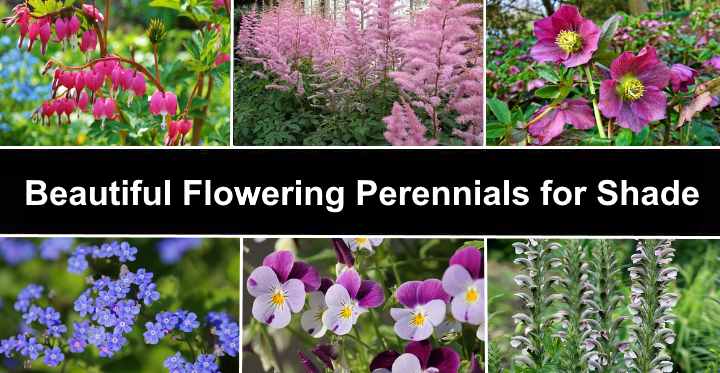
Perennial flowers for shade are perfect for growing in areas of your garden that get little sunlight. Shade-loving perennials grow under trees, large bushes, or landscape areas that are in constant shadows. Some of the best flowering plants for shade include hydrangeas, violets, hellebores, and astilbe flowers. Growing these hardy perennials adds foliage and color to your landscape where other plants won’t grow.
When choosing the right perennial flowers for your shaded front or backyard, it’s vital to know the type of shade in your garden. Some perennials are well-suited to full shade, whereas others grow better in partial shade. There are also some shade-tolerant ground cover plants and shrubs that grow just as well in shade as they do in full sun.
This article is a complete guide to perennials that thrive in the shade. Whether you need plants for full shade or perennials for partial shade, you’ll find what you’re looking for in this list of shade-loving perennials.
Do Perennials Come Back Year After Year?
Most perennials for shaded landscapes return year after year. Perennials are hardy plants that survive harsh winters. Many perennials die back to the ground in winter and then start growing the following spring. The best thing about planting perennials is that you have flowers and foliage in your yard for most of the year, but with minimal care.
Some types of hardy perennials can show signs of decline after thriving for a few years. These perennials flower year after year but then start to die after three or four years. However, there are plenty of perennial types that continue growing and blooming for many years.
What are tender perennials?
Tender perennials are plants that only grow in warmer regions but can’t survive outdoors in icy temperatures. Typically, flowering tender perennials grow best in USDA zones 10 and 11 and warmer areas of zone 9. However, tender perennials usually don’t grow in garden landscapes in zones 7 and below. In these northern regions, you grow tender perennials as annuals or flowering houseplants.
Half-hardy perennials
Some shade-loving perennials are described as half-hardy perennials. These flowers grow in some colder areas and can survive brief cold winters. Half-hardy perennials then return and flower year after year.
Partial shade perennials
Partial shade perennial flowers grow best when they get some morning and evening sunlight. Usually, it’s best to plant perennials for partial shade where they get dappled sunlight—such as under a shade tree or pergola. Partial shade flowering perennials also grow well in an east-facing landscape, protected from intense midday and afternoon sun.
Sometimes, perennials that thrive in part shade are also described as “partial sun perennials.”
Full shade perennials
Full shade perennials are plants that grow well without any direct sunshine. In many cases, perennials for full shade have delicate foliage that burns easily in sunlight. The best places to plant full shade perennials are under trees with large canopies or in north-facing gardens. Perennials for total shade are also perfect for growing along walls or fences that cast shadows for most of the day.
Best Perennials for Shade (With Pictures)
What are the best shade perennials to plant in your garden landscape? Read on to learn about perennials that thrive without direct sunlight.
Fumewort (Corydalis lutea)
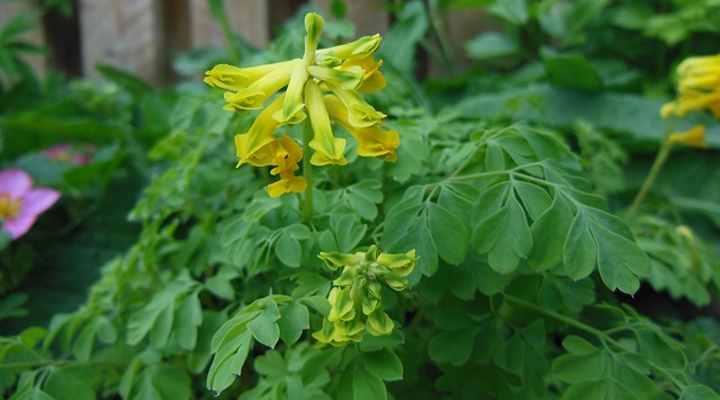
Corydalis lutea is a perennial plant with yellow flowers that thrives in part or full shade
Fumewort is a long-blooming, shade-loving perennial clumping plant that produces attractive yellow tubular flowers throughout the summer. Perennial fumewort grows in mounds that grow up to 2 ft. (0.6 m) tall and 2 ft. (0.6 m) wide. Fumewort thrives in USDA zones 4 through 8.
Fumewort grows best in part shade to full shade. Plant this perennial in mixed beds, shaded rock gardens, cottage gardens, or ground cover for shade. Fumewort is an evergreen creeping plant that doesn’t perform well in hot, humid conditions.
Chinese Astilbe (Astilbe chinensis)

The beautiful pink and purple flowers of Astilbe chinensis add decorative touch in shaded to dappled shade gardens
Chinese Astilbe plants are bushy flowering perennials with fern-like leaves that thrive in full shade or partial shade. Astilbe chinensis flowers are showy clusters of colorful feathery plumes in a conical shape. The beauty of this perennial shade flower is that it has long-lasting blooms.
Chinese Astilbe plants are perennials that bloom all summer long. They grow up to 3 ft. (0.9 m) tall and 2 ft. (0.6 m) wide and thrive in USDA zones 4 through 9. Compact cultivars such as ‘Pumila’, which is a dwarf Chinese Astilbe, are available too.
Chinese Astilbe is an ideal flowering plant for full or partial shade. The adaptable bushy perennial grows best in moist soil. In a shady garden landscape, you can plant Chinese Astilbe along borders or fences, under shade trees, or in containers. If you need beautiful blooming ground cover with flowers in pastel shades, Chinese Astilbe species are ideal.
You can also grow Chinese Astilbe plants as ground cover for full sun if you have cool summers. However, you must keep the ground moist for the plants to thrive in hot weather.
Hardy Begonia (Begonia grandis)
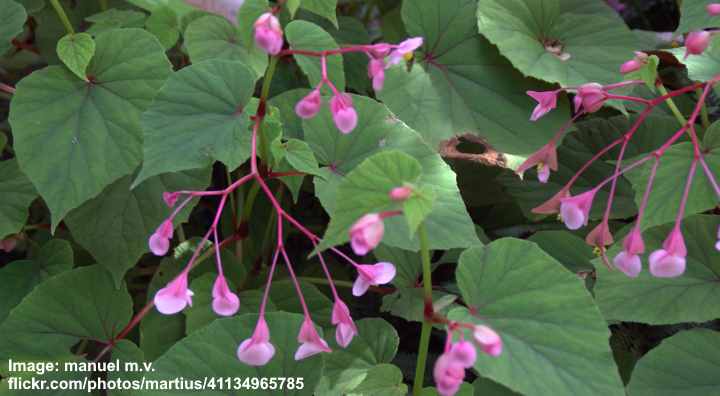
Hardy begonia has delicate pink or white flowers and is a suitable ground cover for full to partial shade
Hardy begonias are bushy shade-loving plants with lush, heart-shaped green leaves and clusters of dainty white or pink flowers. Hardy begonias bloom from midsummer until late fall. The dark, olive-green leaves have red undersides, and they contrast nicely with the whitish-pink flowers.
Hardy begonias thrive in USDA 6 through 9 and come back year after year. For best growth, plant perennial begonias in full to partial shade in organically rich soil. You can plant hardy begonias for ground cover or in containers in shaded patio or deck areas.
Violets (Viola)

Violets are attractive flowering perennials that add wonderful color to shaded landscaped areas
Evergreen perennial violets grow well in part shade and have some of the most dazzling spring flowers from any landscape bedding plant. Some species of violets will bloom in winter in milder areas. Perennial violet flowers can be purple, white, yellow, red, and bicolored pastel shades. Violets grow well in USDA zones 5 through 9.
Violets grow best in mass plantings or growing as an edging, container, or ground cover plant for part shade. To grow violets in your yard, plant the cute plants in moist, well-draining ground. If you live in zone 5, you can also plant violets in full sun—as long as you keep the soil moisture levels high.
Related reading: The best winter plants to grow outdoors.
Barrenwort (Epimedium)
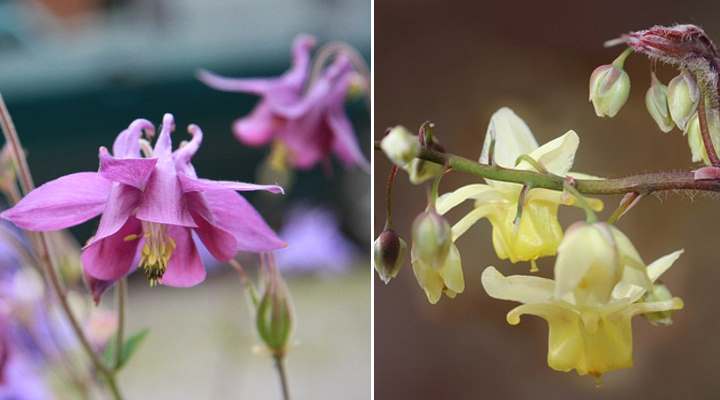
Barrenwort perennial flowers come in array of colors and grow well in shaded areas of your garden
Barrenwort is a spectacular evergreen shade-loving perennial with fascinating, spindly yellow, pink, lilac, and red flowers. These perennial flowers grow in beautiful clusters of drooping flowers growing at the end of tall stems. Also called bishop’s hat, barrenwort has huge, long, striking leaves with spiny edges.
Barrenwort grows best in shade gardens where they help brighten up mixed flower beds, cottage gardens, or shaded areas under trees. You can also plant barrenwort as ground cover.
Barrenwort thrives in USDA zones 5 through 9, and the bushy plant grows up to 2 ft. (0.6 m) tall and 3 ft. (0.9 m) wide.
Hellebore (Helleborus) – Lenten Rose
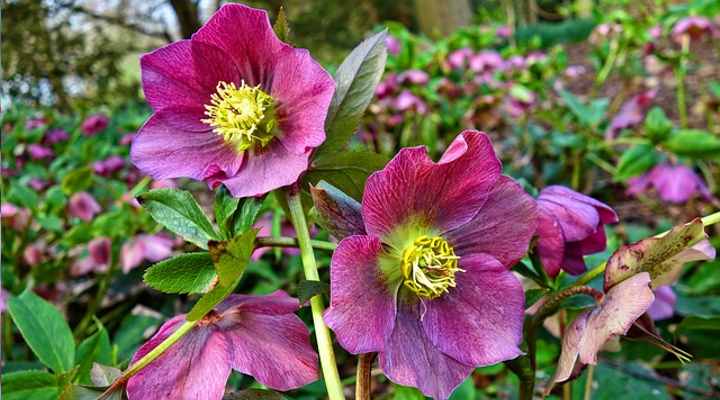
Hellebore is a cold hardy flowering perennial that prefers partial to full shade
Hellebore is a cold-hardy shade species with attractive leathery green leaves and large, star-shaped showy flowers. These flowering perennials bloom from early to late winter through spring. The rosette-form Helleborus flowers are in shades of pink, red, green, white, and orange—ideal for brightening any shade garden.
The long-lasting flowers bloom for many weeks during winter and spring. Also called winter roses, hellebore plants grow best in shady borders, under trees, or as mass plantings for shade ground cover. Grow perennial hellebore flowers in USDA zones 4 through 9.
Foamflower (Tiarella cordifolia)
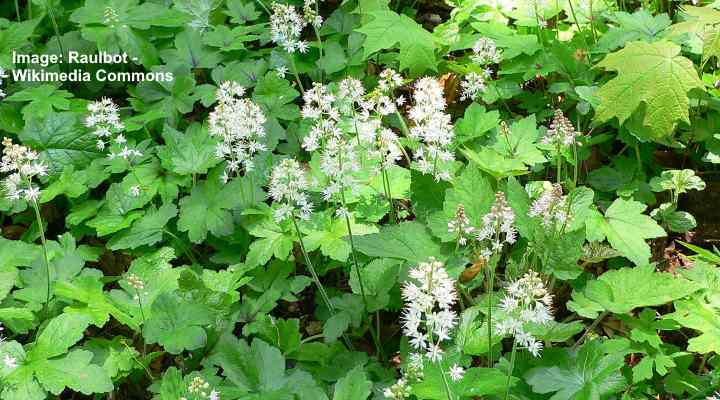
Foamflower is a great white flowering creeping perennial for partial or full shade
Foamflower is a low-growing perennial plant with maple-like leaves and clusters of fuzzy-looking white flower spikes growing on erect stems. Ideal for underplanting shrubs, foamflower plants don’t need sunshine to flourish. The charming whitish flowers bloom for six weeks, and the creeping foliage quickly covers the bare ground.
Foamflower grows up to 12” (30 cm) tall and 24” (60 cm) wide. The best place to grow this flowering perennial is in flower beds, along borders, or under shade trees. You can also grow the perennials as pretty, evergreen ground cover in milder climates. Foamflower thrives in USDA zones 3 through 8.
Leopard plant (Ligularia)
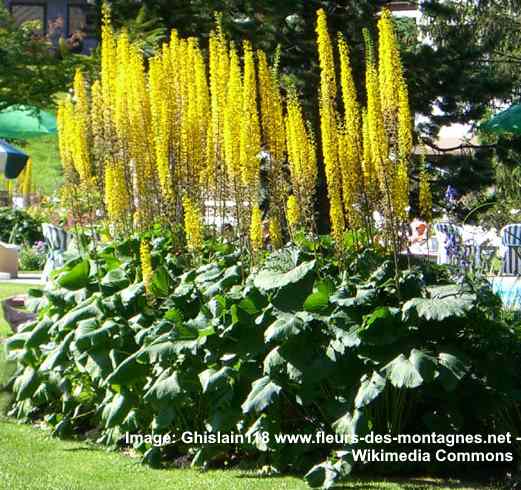
The tall yellow flowers of the leopard plant will look great at the back of partly shaded flower beds
The leopard plant is a clumping perennial that is suitable for part sun or dappled shade. The foliage on the leopard plant forms mounds and tall, conical flowering spikes (racemes) covered in small, yellow, daisy-like flowers. The racemes grow up to 5 ft. (1.5 m) tall. The impressive blooming spikes appear in midsummer and last for a few weeks.
This hardy flowering perennial makes excellent ground cover due to its huge, 12-inch (30-cm) leaves.
Due to the height of the flowers, the leopard plant grows best at the back of flower beds or along borders. This perennial also prefers damp, moist soil and is suitable for growing beside garden ponds or along streams.
Related reading: The best plants to grow beside ponds.
Green and Gold (Chrysogonum virginianum)
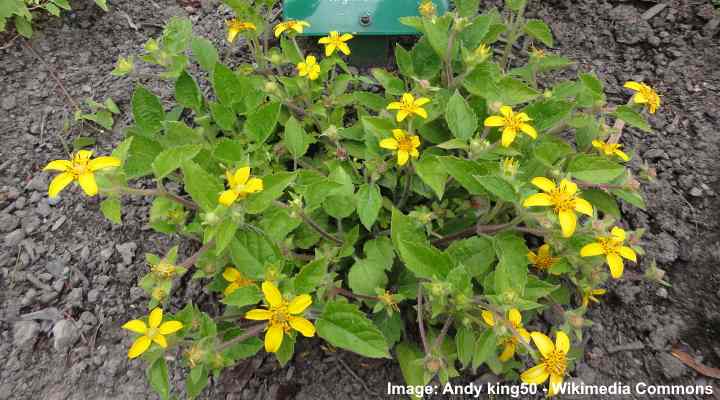
The creeping nature of Green and Gold makes it ideal as a ground cover flowering perennial for partial shade
Green and gold is a low-growing perennial that grows best in partial shade. The dense green foliage is made up of tight clumps of triangular green leaves with toothed edges. One of the most attractive features of this perennial is its dainty, star-shaped bright yellow flowers. The green and gold colors are prominent in spring until midsummer.
Green and gold only grows 12” (30 cm) high, making this creeping perennial ideal as ground cover for part shade. You can also grow this delightful mounding plant along driveways, paths, or as foundation plantings.
Green and gold is suitable for growing in USDA zones 5 through 9.
Bear’s Breech (Acanthus mollis)
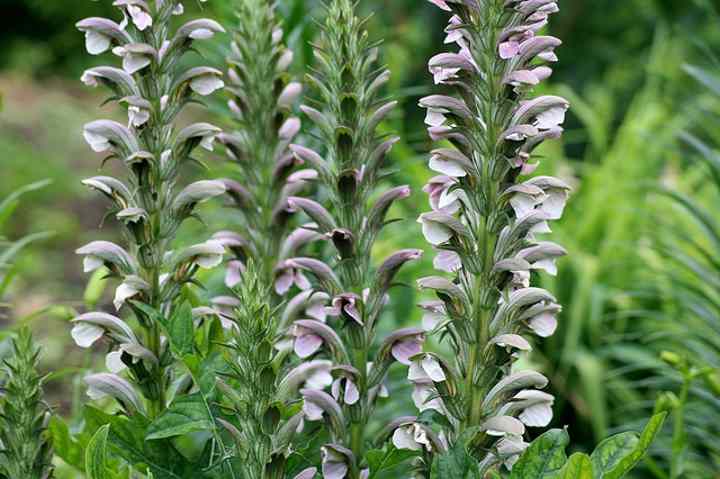
Bear’s breech has long white and purple flowers and grows best in full to partial shade in hot climates
Bear’s breech is a fast-growing flowering perennial that grows best in partial shade in hot climates. The semi-evergreen clump-forming plant produces tall white and purple flowering spikes. The tall flowers contrast nicely with the glossy dark green leaves. Bear’s breech is suitable for zones 7 through 11.
In cooler climates, bear’s breech also grows well in full sun if the ground is kept constantly moist. Bear’s breech grows best in the partial shade wherever you need tall perennial flowers. Acanthus mollis is also a relatively drought-tolerant perennial plant once established.
Hydrangea
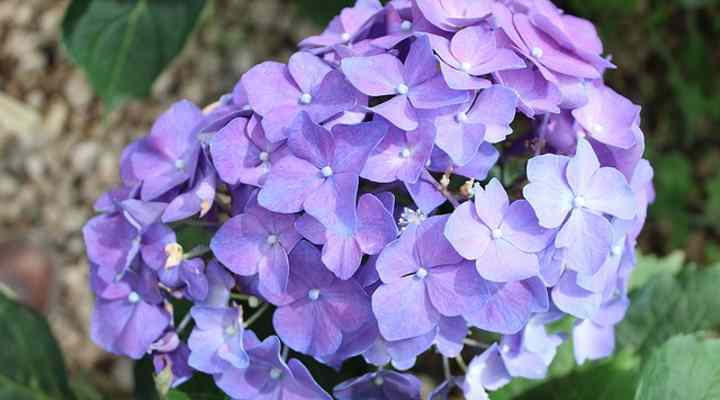
Hydrangea macrophylla (in the picture) prefers morning sunlight and dappled shade in the afternoon
Some hydrangea shrubs are suitable for full shade or part shade. These perennial flowering plants’ striking feature is their giant flower heads that can grow up to 14” (35 cm) across. The re-blooming flowers appear in early summer and continue blooming until fall. Hydrangeas also have large glossy, dark green, ovate leaves with serrated margins.
The types of shade-happy hydrangeas are the mophead hydrangeas (Hydrangea macrophylla) and climbing hydrangea (Hydrangea anomala subsp. petiolaris).
The mophead hydrangea thrives in USDA zones 6 through 9 in dappled light or part shade. These perennials have large, round flower heads and grow best as foundation plantings, container plants, or a flowering privacy hedge.
Climbing hydrangeas grow best in USDA zones 4 through 9. The pretty white flowers almost cover the foliage when in bloom from late spring until fall. The best landscape use of climbing hydrangeas is to cover walls or fences. You can also grow these hydrangeas up arbors or pergolas to create an attractive garden feature.
Periwinkle (Vinca)

Periwinkle is an easy to care for flowering perennial which is a shade-tolerant ground cover
Periwinkles are vigorous mat-forming perennials that grow just as well in the shade as in the full sun. The purple to blue star-shaped flowers appear on this ground cover plant in mid-spring and last until summer. The dark green lanceolate leaves and 5-petaled flowers form a dense carpet of green and purple colors—even when underplanting shrubs in full shade.
Periwinkle plants are low-maintenance ground cover plants for shaded garden areas in zones 4 through 9.
Plantain Lily (Hosta)

Hosta plants are mainly grown in the shade for their attractive foliage but most hosta types produce flowers on long stems during the summer which add to their beauty
Plantain lilies are the perfect shade garden foliage plants in zones 3 through 8. Species of Hosta plants have clusters of funnel-shaped white or pale purple and pink flowers that bloom in early summer. However, compared to the large attractive heart-shaped colorful leaves, the flowers are relatively insignificant.
Hosta plants are some of the most popular ground cover and edging plants for shaded landscapes. You can also grow these mound-forming perennials in containers to brighten a north-facing balcony, deck, patio, or entranceway.
Bleeding Hearts (Dicentra)
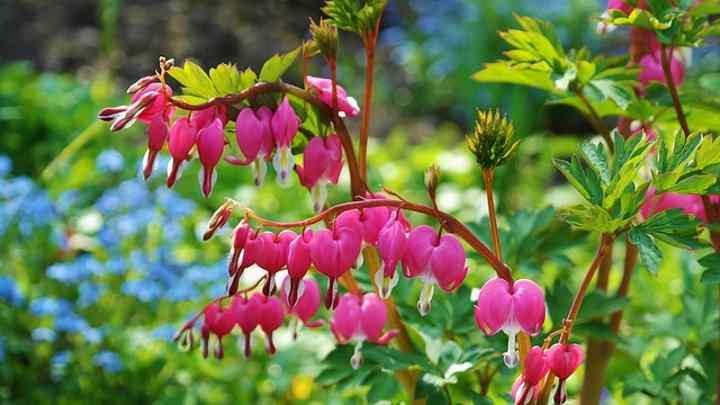
Bleeding hearts is a shade loving perennial with unusual looking flowers
Bleeding heart plants are shade-tolerant perennials with unusual heart-shaped flowers that are red, pink, or white. The attractive flowers dangle from arching stems, creating a row of hearts that seem to bleed. This adaptable perennial grows in full shade; however, you may not get as many flowers. When growing in full sun, the ground should be kept constantly moist.
Bleeding hearts grow best in partially shaded borders or as ground cover in part to full shade.
Siberian Bugloss (Brunnera macrophylla)
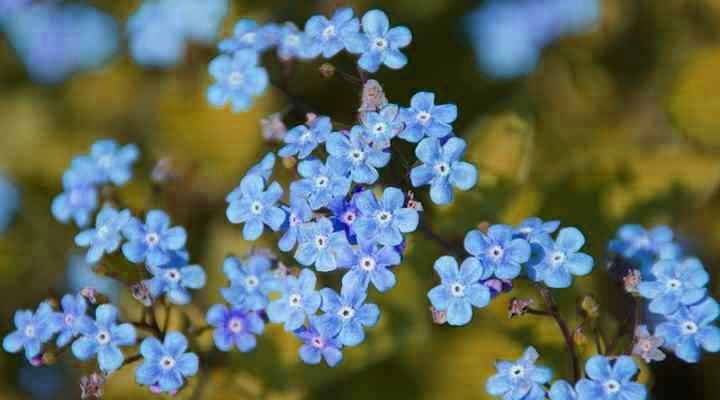
Siberian Bugloss is an attractive ground cover for partial shade or full shade with small and pretty blue flowers
Siberian bugloss is a cold-hardy flowering perennial with large heart-shaped leaves and tiny clusters of delicate light-blue flowers. The dense evergreen foliage thrives in shade and cool, moist conditions. This low-growing shade plant grows in clumps up to 2 ft. (0.6 m) tall and 3 ft. (1 m) wide.
Siberian bugloss grows best in beds and borders, beside ponds, or en masse as ground cover. This perennial species is suitable for USDA zones 3 through 8.
Monkshood (Aconitum napellus)
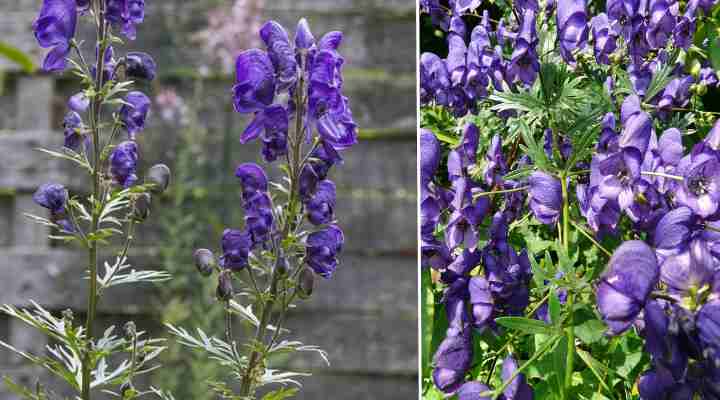
Monkshood is a tall flowering perennial that tolerates partial shade very well
Monkshood—also called wolfsbane or aconite—is a partial shade loving perennial with purple bell-shaped flowers growing on long leafy stems. The common name of Aconitum napellus refers to the flowers that look like a medieval monk’s hood. Also, the plant contains toxins and is extremely poisonous.
Monkshood grows best in moist, damp soil in USDA zones 3 through 7. However, it’s not a good idea to plant this perennial in gardens where pets or young children play due to its severe toxicity.
Lungwort (Pulmonaria)
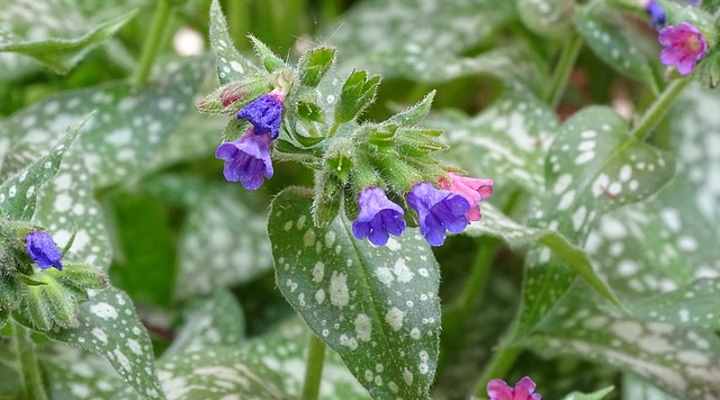
The shade loving Lungwort is a low growing plant with pretty flowers and attractive foliage
Lungwort is a beautiful landscape perennial flower with red, purple, or pink pendulous, bell-shaped papery flowers. The pinkish or purple funnel-like flowers and green, ovate leaves with white speckles are perfect for brightening up shaded landscape areas. This clump-forming plant is low-growing and only reaches 12” (30 cm) tall and 18” (45 cm) wide.
The best places to plant perennial lungwort are under roses or shrubs, shady paths or driveways, or ground cover for complete shade.
Dead Nettle (Lamium)
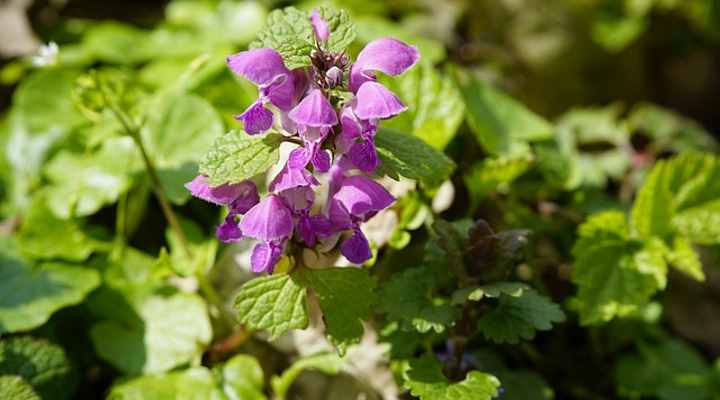
Dead nettle is a fast growing ground cover for the shade with pink or white small flowers
Dead nettle is a species of dense, mat-forming, semi-evergreen perennials with triangular to ovate leaves and unusual two-lipped pink and white flowers. This fast-growing plant can quickly cover shaded woodland areas, bare ground under trees or shrubs, and thrive in north-facing gardens. The varieties of dead nettle with silvery-green leaves perform better in part shade.
As shade-loving perennials, dead nettles grow best as edging plants in shady landscapes. You can also grow dead nettle in mixed flower beds or containers.
Lily of the Valley (Convallaria majalis)
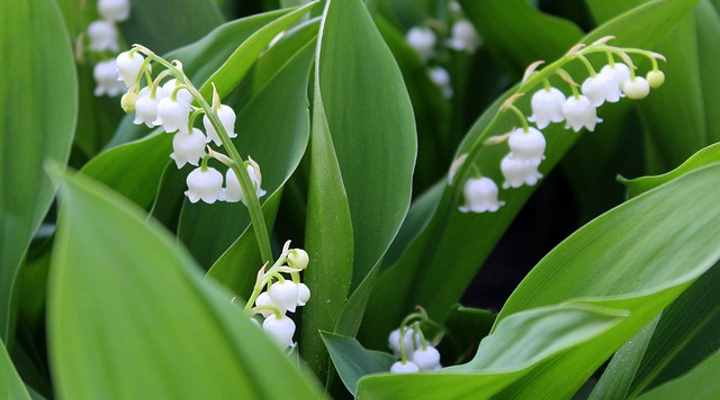
Lily of the Valley is a ground cover perennial for full or part shade with delicate white flowers
Lily of the valley is a flowering leafy perennial that grows well in full shade to partial shade. The outstanding feature of this full shade perennial is the heavily-scented bell-shaped white flowers that dangle from short, arching stems. These dainty floral stems grow among shiny lance-shaped glossy, green leaves.
Lily of the valley is cold-hardy in zones 2 through 7. The clumping perennials grow between 6” and 12” (15 – 30 cm) tall. The fast-spreading plant is excellent for ground cover in the shade, where it creates a dense carpet of lush green foliage.
Related articles:
